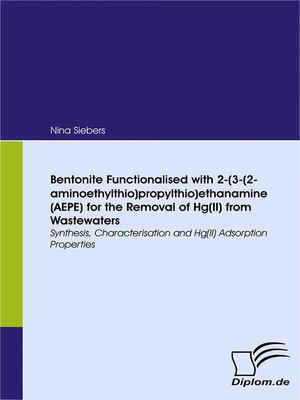Bentonite Functionalised with 2-(3-(2-aminoethylthio)propylthio)ethanamine (AEPE) for the Removal of Hg(II) from Wastewaters
ebook ∣ Synthesis, Characterisation and Hg(II) Adsorption Properties
By Nina Siebers

Sign up to save your library
With an OverDrive account, you can save your favorite libraries for at-a-glance information about availability. Find out more about OverDrive accounts.
Find this title in Libby, the library reading app by OverDrive.



Search for a digital library with this title
Title found at these libraries:
| Loading... |
In this study, natural bentonite clay was first purified and then functionalised with the chelating ligand 2-(3-(2-aminoethylthio)propylthio)ethanamine (AEPE) to improve the adsorption capacity and selectivity towards Hg(II) ions. The surface modification was characterised with the help of powder X-ray diffraction (XRD), Fourier transform infrared spectroscopy (FT-IR), BET isotherm to determine the specific surface area while the thermal stability of the samples was studied using thermogravimetric analysis (TGA). FT-IR and TGA demonstrated the presence of the chelating ligand on the modified clay. XRD pattern indicated that the chelating agent AEPE was only grafted onto the surface of the purified bentonite, whereas the interlayer distance did not change. N2 specific surface area measurement also indicated the coverage of AEPE onto the surface of purified bentonite.
Adsorption of Hg(II) ions from aqueous solutions as a function of pH, contact time, initial concentration, ionic strength, interfering ions and adsorbent dose was studied. The adsorption process followed a pseudo-second order kinetics and monolayer adsorption. The adsorption of Hg(II) ions increased with increasing pH and reached a plateau value in the pH range of 4.0-8.0. The removal of Hg(II) was found to be higher than 99% at an initial concentration of 20 mg/L using adsorbent dose of 0.01 g. The presence of NaNO3 as background electrolytes at concentration ranging from 0.01 to 2.0 M decreased the adsorption of Hg(II) ions. Furthermore, the adsorption capacity increased with increasing adsorbent dose. Sorption data analysis was carried out using Langmuir isotherm for the uptake of Hg(II) ions at a concentration range of 20-400 mg/L. The adsorption process was found to be favourable as the separation parameter is less than unity (RL<1). The maximal adsorption capacity was found to be 48.69 mg/g obtained from Langmuir equation.






